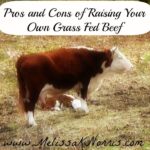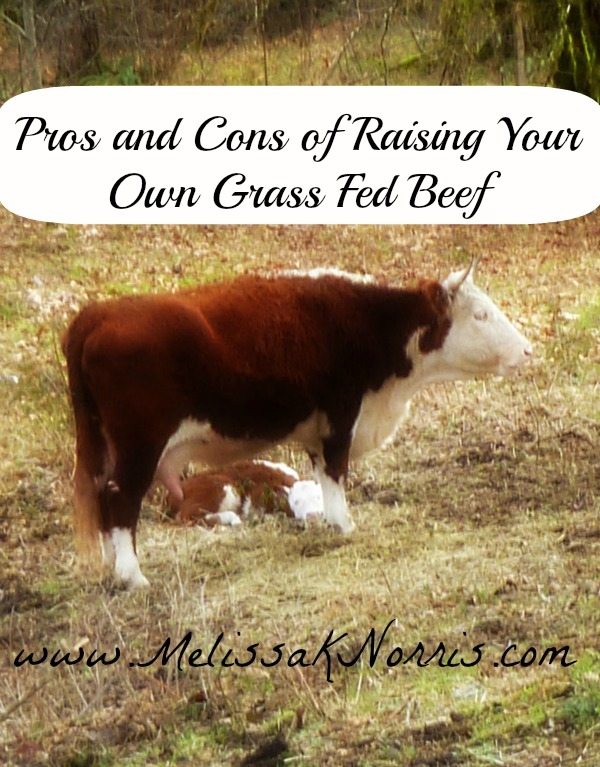How to Raise Grass Fed Beef


I grew up on a small cattle ranch nestled in against the foothills of the North Cascade Mountains. White face Herefords dotted the green pasture like daisies. The sound of my father's old red Ford pickup truck rolling across the dirt track of the long abandoned railroad track called the herd better than any cattle dog.
Every evening from October to May, I drove the truck while Dad tossed out about 35 bales of hay from the back. We've never bought beef from the store. After my husband and I were first married, we ran out of beef (never to be repeated) and had to purchase some meat from the store until butchering time rolled back around.
I had never cooked store bought meat. I had no idea how different it was, and not in a good way. The odor (it wasn't rancid or bad, but it smells different) made my nose curl. I couldn't believe the amount of liquid I had to drain even though I'd purchased lean. And the taste. It was the difference between real sweet cream butter and margarine.
We now have our own herd of natural grass fed beef. I use the term herd generously as we only have 6 cows. Like any homesteading venture, there are pros and cons.
Cons
Space-Unlike chickens, cows need more than just a backyard, so you need some acreage to raise cattle. Depending upon your climate, an acre per cow is a good rule of thumb.
Cost of feed-Even with adequate pasture, you'll have to purchase feed for the winter months. Our hay bill is usually around $900 for the year, depending on the season, and going rate.
Fencing-There's the initial cost of fencing. We use barbed wire. It's fairly easy to put up and unlike electric fence where you have to worry about the electrical ground, weeds/brush touching the wire, and a constant power source, barbed wire is good to go. However, cattle can be notorious for getting out of any fence. Be ready to herd them back.
Care-Cattle don't take an extreme amount of care, but they do require some. They need a constant supply of fresh clean water, and during the winter, feeding.
Breeding-If you keep a cow to breed back every year, you either have to purchase a bull, artificially inseminate, or haul your cow to a bull or a bull to your cow every year. Unless, you're lucky enough to have a bull in the neighboring field who hops the fence when it's time, and then goes back home. (This only happened to us one year and was with a bull we didn't mind cross-breeding)
Pros
Taste-You can't beat the taste of naturally grass fed beef. I'd talked about the difference so passionately that a co-worker bought half a beef from us. (This isn't a sales pitch as we can't meet the demand now) After having our beef, his wife refused to ever go back to store bought beef. You can taste the difference!
Price-While the cost of feed can be a lot up front, the cost of natural grass fed beef is much cheaper to raise than to buy in the store. Our local butcher charges a $55 kill fee (divided by how much of the beef you purchase) and $.50 per lb cut and wrap. If you butcher and wrap it yourself, then this cost is eliminated. Beef tastes better when allowed to age and as we don't have the proper hanging facilities, we hire ours out. The average rate in our area is between $2.10 and $2.75 a lb, making every cut of beef around $3.00 a pound, including your expensive cuts of steak.
Plus, you get to decide which cuts of meat you want and how it's packaged.
Peace of mind– I know exactly what goes in to our cows. We buy our hay locally from local fields so I know they haven't been treated. Our own pasture is managed organically, even though we're not certified. (It costs too much for our tiny operation) Our cattle are cared for humanly. I'll never have to worry about my children eating pink slime.
While raising your own grass fed beef isn't for everyone, if you have acreage, it's something to consider. I love that my children grow up knowing where the food comes from. And I suspect they'll be as grateful of that as I am now.
Even if you can't raise your own, you can look for a local ranch, and purchase from them. Or contact your local butcher and ask for referrals.
For more info on raising your own beef, listen to our Pioneering Today Podcast Episode #24 Raising Your Own Grass Fed Beef
Do you raise your own beef? Have you ever tasted homegrown beef?
Other Posts You May Enjoy
- Planning Our Livestock to Raise a Year's Worth of Food
- Stocking Up on Animal Feed (+ How Much to Feed Animals)
- Raising Your Own Grass-Fed Beef
- When Butchering a Cow the Best Cuts of Meat to Get
- Raising Grass-Fed Beef – What to Know on Butchering Day
- How to Butcher a Chicken
- Tips on Raising Chickens for Meat
- Raising Meat Chickens for Profit
- Raising American Guinea Hogs
- American Guinea Hogs – Were They Worth It?
- Tips on Raising Pigs for Meat
- A Guide to Raising Goats
- Raising Sheep for Fiber & Naturally Dyeing Wool
- Everything You Need to Know About Raising Rabbits for Meat
- How to Keep Animals Cool in Hot Weather
Source: https://melissaknorris.com/raising-your-own-grass-fed-beef/
0 Response to "How to Raise Grass Fed Beef"
Postar um comentário